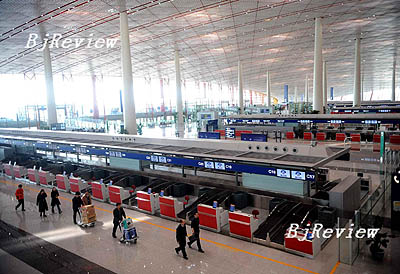|

"Imagine (all five) Heathrow terminals under one roof and then add an extra 17 percent of floor space," said Briton Norman Foster. The famous architect was talking about the third terminal (T3) of Beijing Capital International Airport (BCIA) designed by him.
As one of the most important projects for the Beijing Olympics, T3, which cost 27 billion yuan ($3.8 billion), was put into use on February 29. The building covers 98 hectares of floor space, equivalent to about 170 football pitches. It runs almost 3 km from south to north. The parking tower alone, which occupies 340,000 square meters, is triple the size of the National Stadium.
"It has taken Heathrow 50 years to grow to its present scale. In Beijing, the process should be completed in less than five. Here is society changing by the power of 10," said Foster.
The opening of T3 makes BCIA the only airport in China that has three terminals, double towers and three airport runways. The number of the boarding gates in T3 is double the total number of Terminal 1 and Terminal 2. "The take-off and landing capacity has been upgraded from 1,000 flights per day to between 1,700 and 1,800 flights per day, including large aircraft of the new generation, such as the A380 of Airbus," said Zhang Guobao, Vice Minister of the National Development and Reform Commission.
Passengers can easily lose direction in large airports, but this is less likely in T3. "Because all the steel pipes on the roof are designed in a north-south direction, as long as passengers raise their heads, they will easily be able to tell their direction by the pipes," said Fan Jun from the Beijing Urban Construction Group.
Unavoidably, T3 has also raised some doubts and arguments over its huge cost and size. Zhu Jingyuan, Designer in Chief of BCIA Expansion Project Department, has her own opinion on this issue. In China, one third of flights will take off and land at BCIA, and more than a quarter of the passengers will come and go through BCIA. "The airport is a barometer of economic growth. If we don't build a large enough airport, it will not be able to meet demands in near future, and the extension and reconstruction of the airport will cost even more," said Zhu.
The first terminal of BCIA was built on March 1, 1958. At that time, it occupied more than 10,000 square meters, and could handle 230 passengers per hour at its busiest hours. In 1991, the number of passengers coming and going reached 8.7 million. The single terminal was unable to deal with this number so Terminal 2 was designed and put into use in November 1999. After just three years, it was unable again to meet the demands of rising passenger numbers.
According to estimations by the civil aviation authorities of China, the annual number of passengers coming and going through BCIA will reach 60 million in 2015 and the volume of freight handled will reach 1.8 million tons. "During the Olympic Games in August, the volume of passengers will reach 5.56 million. The figure is very close to the estimated flow in busiest months in 2015, and the new terminal can totally meet the demand," said Li Jiaxiang, Director of China Civil Aviation Administration.
The increased capacity will consolidate the status of BCIA as the world's eighth biggest airport, and it is expected to become one of the five biggest airports in the world.
Dragon-like
From the sky, the shape of T3 is like a dragon lying in the northeast of Beijing.
Dragon is the totem of China, a symbol of strength and good fortune. The whole terminal can be divided into five parts.
The "dragon head" is the traffic center and parking tower, which has 7,000 parking lots.
The "dragon body" refers to three functional areas: C, D, E. Area C houses passenger check-in, luggage claim and domestic boarding. D area is reserved temporally for flights during the Olympics and Paralympics. Area E is the international airport lounge.
There are no obstacles blocking vision between the functional areas and the external walls are all transparent glass. Stepping into the check-in hall, passengers will feel like they are standing under the sky with changing clouds overhead.
The terminal is designed so that passengers will not feel tired even after walking a long distance, because they walk downward all the way, and in the opposite direction can be carried by escalators or battery-driven cars.
| 